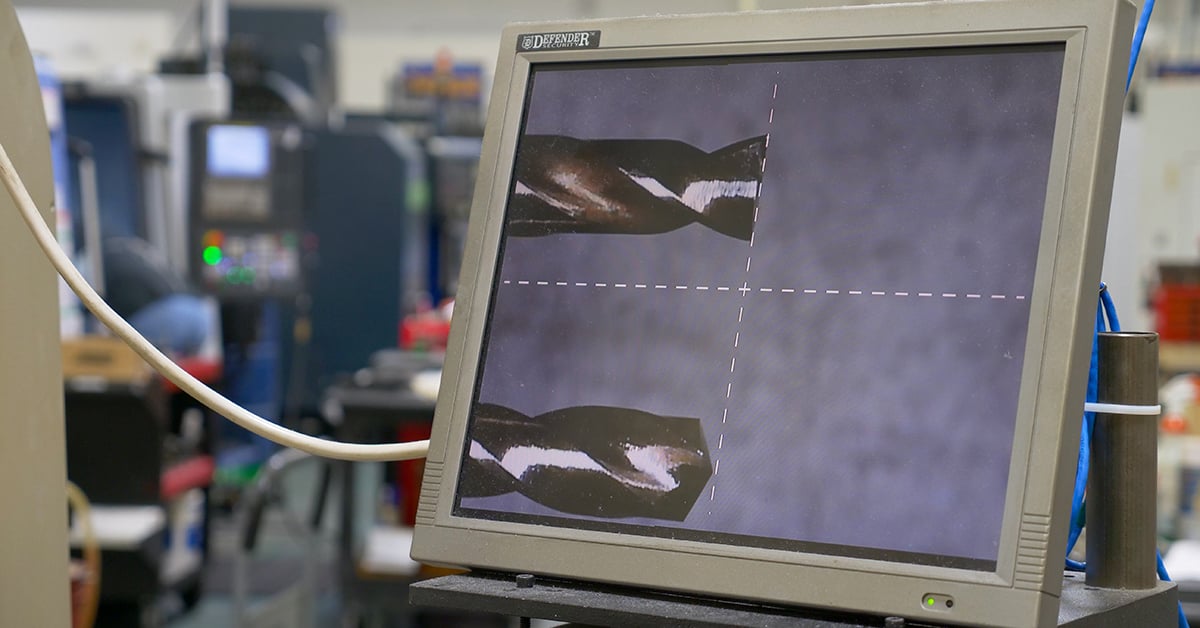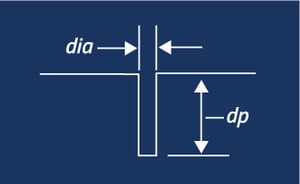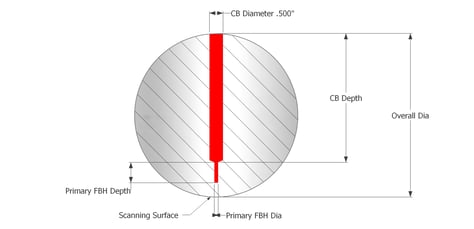 PH Tool offers many different types of holes used in NDT today. Of these different hole types, the flat-bottom hole (FBH) is by far the most commonly made. The FBH is king in the ultrasonic testing world due to the simple fact that it is excellent at reflecting sound directly back at the transducer. They provide a perfect “disc-shaped,” planar reflector that can be used to set instrument sensitivity, evaluate resolution, and can be used for flaw sizing comparisons. It is also possible to create “distance amplitude” reference curves using a series of FBHs of the same size, drilled to different depths, or “area amplitude” reference curves using a series of FBHs at the same depth, but of varying diameters.
PH Tool offers many different types of holes used in NDT today. Of these different hole types, the flat-bottom hole (FBH) is by far the most commonly made. The FBH is king in the ultrasonic testing world due to the simple fact that it is excellent at reflecting sound directly back at the transducer. They provide a perfect “disc-shaped,” planar reflector that can be used to set instrument sensitivity, evaluate resolution, and can be used for flaw sizing comparisons. It is also possible to create “distance amplitude” reference curves using a series of FBHs of the same size, drilled to different depths, or “area amplitude” reference curves using a series of FBHs at the same depth, but of varying diameters.
We employ both conventional machining (drilling) and nonconventional (EDM) machining in the hole-making process. The determining factors we consider in choosing a method are machinability of the workpiece, accessibility, hole diameter and depth. Most FBHs are drilled in the range of 0.250” (6.25mm) diameter and under. Many specifications call for them to be drilled in increments of 1/64 inch. PH Tool regularly drills holes in the range of 1/64 inch thru 8/64 inch for most applications. Our modern CNC milling centers allow us to conventionally drill FBHs in workpieces down to 0.010” (0.25mm) in diameter.
 Smaller holes are machinable via EDM. With recent investments in CNC-controlled fine-hole EDM machines, our capability for drilling extremely small FBHs has dramatically increased. With EDM technology, we have successfully machined FBHs down to 0.004” (0.10mm) in diameter. We are constantly pushing the envelope on what we thought was possible by machining FBHs in tough materials like high-nickel superalloys, tool steels, titanium, and more. We blow right past the drill manufacturers’ recommendations when it comes to drill diameter/depth aspect ratios.
Smaller holes are machinable via EDM. With recent investments in CNC-controlled fine-hole EDM machines, our capability for drilling extremely small FBHs has dramatically increased. With EDM technology, we have successfully machined FBHs down to 0.004” (0.10mm) in diameter. We are constantly pushing the envelope on what we thought was possible by machining FBHs in tough materials like high-nickel superalloys, tool steels, titanium, and more. We blow right past the drill manufacturers’ recommendations when it comes to drill diameter/depth aspect ratios.
When the bar and tube industry adopted sophisticated, in-line phased array ultrasonic and eddy current technology to inspect their product, they turned to PH Tool to manufacture their complex calibration standards. In the past, if customers needed deep FBHs drilled, the standard would have needed to be “stepped” due to machine and tooling limitations. Thanks to the experience and pioneering spirit of PH Tool, our customers can now calibrate on large-diameter standards that are not compromised with invasive steps or access pockets and slots. To support this effort, we have added several vertical CNC mills dedicated to deep FBH drilling. The largest of these has been modified to have an incredible Z-axis travel of 41 inches. Combined with specially-engineered tooling, PH Tool can now drill FBHs at 20 inches deep into a 21 inch diameter bar! This is achieved through the use of a larger pilot hole (a.k.a. – “counterbore”) that allows us to slip a tooling extension and precision collet for the smaller drill down to the final required depth.
 PH Tool employs a trustworthy process to machine and mechanically measure FBHs. The holes are peck-drilled to within a few thousandths of an inch of the final depth, using a standard, pointed drill bit. A skilled toolmaker then grinds the bit to 180° (flat) under high magnification in-house on a Swiss-made precision drill grinding machine. The drill is inspected on a calibrated, NIST-traceable video measurement system to ensure flatness before and after drilling the last few thousandths of the hole. We use gauge pins to determine the finished diameter of the hole, and then use a calibrated depth gauge with a pointed pin to determine the depth. The depth we measured using the pointed pin is then compared against that of a flat pin, to ensure there is no concavity at the hole bottom.
PH Tool employs a trustworthy process to machine and mechanically measure FBHs. The holes are peck-drilled to within a few thousandths of an inch of the final depth, using a standard, pointed drill bit. A skilled toolmaker then grinds the bit to 180° (flat) under high magnification in-house on a Swiss-made precision drill grinding machine. The drill is inspected on a calibrated, NIST-traceable video measurement system to ensure flatness before and after drilling the last few thousandths of the hole. We use gauge pins to determine the finished diameter of the hole, and then use a calibrated depth gauge with a pointed pin to determine the depth. The depth we measured using the pointed pin is then compared against that of a flat pin, to ensure there is no concavity at the hole bottom.
Thank you for reading our blog on FBH drilling. If you would like to learn more, please visit our website page, watch our FBH video, or call a member of our sales team today!




